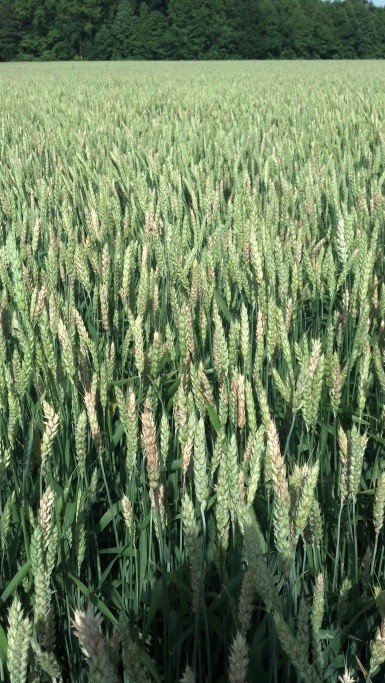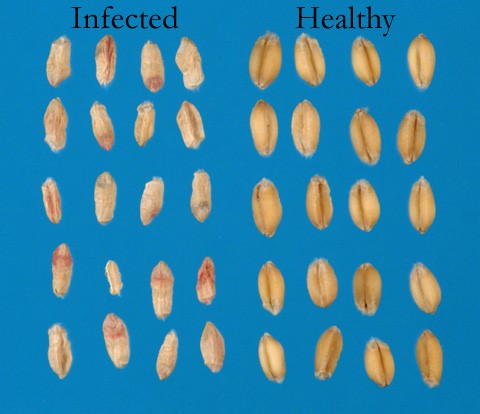Fusarium head blight (FHB), or head scab is widely considered to be the most problematic disease impacting wheat production in the United States. In Illinois, the disease is predominantly caused by the fungus, Fusarium graminearum.
Symptoms of FHB include infected wheat heads, often partially bleached, and infected kernels which may have an orange/pink color at the base of the spikelet (Figure 1).


Figure 1. Wheat heads with bleaching due to FHB (Photo N. Kleczewski left and P. Sylvester right).
Kernels may become shriveled and chalky white or pink (Figure 2). These shriveled grains are commonly referred to as tombstones.
The fungus can produce toxins, most notably deoxynivalenol (DON or vomitoxin), which is known to have deleterious effects on some livestock and, potentially, humans if consumed in sufficient amounts. Consequently, grain can be docked or rejected if DON levels exceed advisory levels established by the FDA (Table 1).

Figure 2. A comparison of FHB infected and healthy kernels. Infected kernels are shriveled and lightweight and commonly called tombstones. Image from Schmale, III., D.G. and G.C. Bergstrom. 2003.
| Table 1. Allowable levels of FHB-induced DON in wheat grain | |
| Maximum allowable DON level (ppm) | Consumer |
| Human consumption | 1ppm
Finished wheat products (flour, bran, germ) |
| Swine | 5ppm
Not to exceed 20% of finished feed ration |
| Poultry | 10ppm
Not to exceed 50% of finished feed ration |
| Ruminating beef and feedlot cattle more than 4 months old | 10ppm
Not to exceed 50% of finished feed ration |
| All other animals | 5ppm
Not to exceed 40% of diet |
Management of FHB starts with managing DON. How do you best manage DON? Below are the tools growers have at their disposal. Think of managing DON as being a well-trained martial artist—the more moves you have, the more likely you are to win your match. Nobody wants to be the guy who goes out and straight-jabs all day.
- Plant a moderately resistant variety. There are many varieties available that will help reduce potential DON levels. These varieties don’t provide complete resistance but do reduce DON by roughly 50 percent when compared to susceptible varieties. The nice thing is that newer moderately resistant varieties yield better than those from 10 years ago in the absence of FHB.
- Properly apply a fungicide labeled for FHB suppression if conditions are conducive for disease. You have 6 days from the start of flowering (when 50 percent of the main tillers have yellow anthers popping out) to make an application. Research shows that this window is likely to give you the best efficacy. Remember, these products only suppress FHB and don’t cure an infection. Recommended products such as Prosaro® and Caramba® reduce DON by only 42 – 45 percent, respectively. Products such as tebuconazole (Folicur® and generics) in comparison, reduced DON by only 23 percent and propiconazole (Tilt® and generics) by 12 percent. Make sure you apply at the recommended volume and follow all label directions to ensure adequate coverage of the head.
- Till the ground if possible. This suggestion may not be practical for no-tillers, but anything you can do to bury or hasten residue decomposition will reduce local inoculum buildup.
- Plant wheat after soybeans. This is easier said than done. However, F. graminearum does not grow as well on soybean residue as it does on corn or small grain residue. This tactic can provide additional benefits in terms of reducing DON levels and risk.
And remember that FHB is different from fusarium crown rot. I hear people mention seed treatments for managing FHB. This is a residue-borne disease that affects the flowering head. This is not a seed-borne disease. For more detailed information on FHB/DON management visit University of Illinois field crop disease blog to learn more.
All trademarks are the property of their respective owners.


 and then
and then